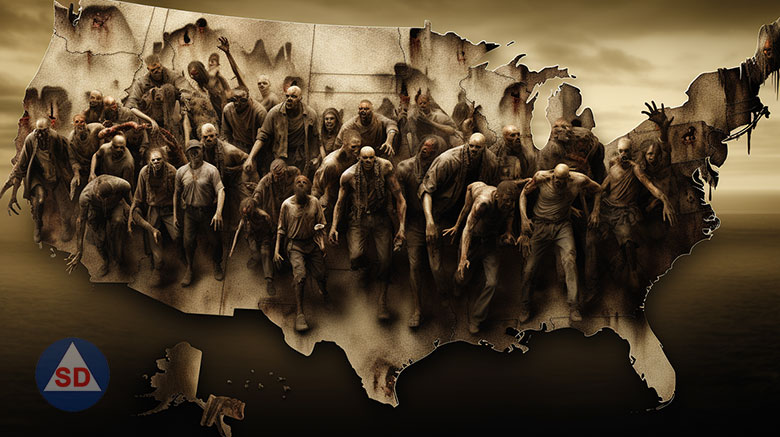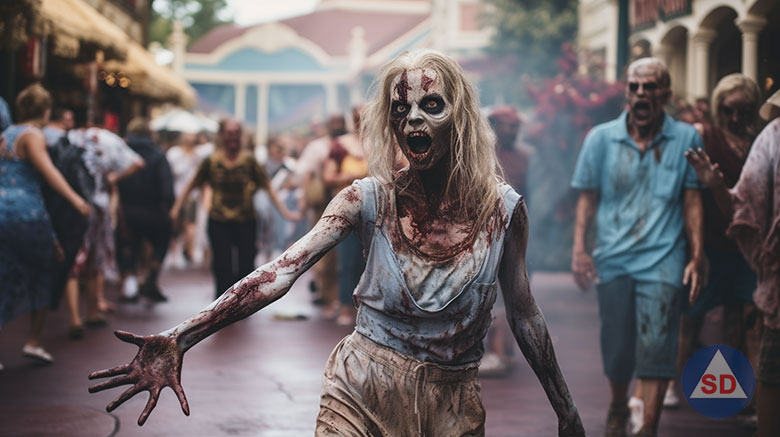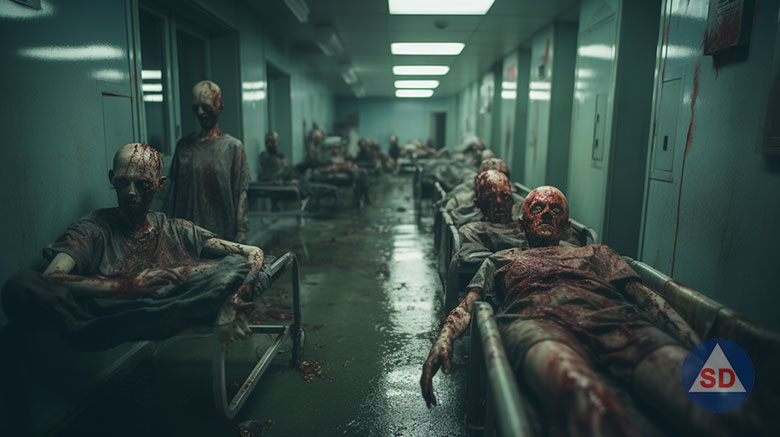
It’s happened. It’s 28 Days Later, Night of the Living Dead, and The Walking Dead. Take your pick of any one of the other countless zombie apocalypse movies as your reference point, but let’s say it’s happened and now you need to find the safest states in a zombie apocalypse to migrate to.
There are, of course, studies on this topic, but they’re flawed. We’re going to look at why they’re flawed and then I’m going to go into the details of my own study on this topic and go through the results that I find.
By the time you’re done reading this article, you’ll have an understanding of my logic and I’d appreciate it if you left a comment letting me know where your state ranked in my analysis and what – if any – criteria you think I should have included that I left out.
Alternatively, if you’d rather watch than read, see my latest YouTube video on this very subject.
Other Studies
Could a zombie apocalypse really happen? It’s a reasonable question, but it’s a question that has different meanings depending on who’s posing the question. Fans of zombie fiction post the question as a make believe, hypothetical imagination of a post-collapse world. Preppers, on the other hand, they often speak of the “zombie apocalypse” as a means to describe any type of situation where the collapse happens and everyone is fighting each other for survival. It’s a safer way to describe what might one day come.
When people talk about the safest states in a zombie apocalypse, they’re often using criteria for the former, reanimated humans. The undead. That said, what makes one state safer in a zombie apocalypse also makes a state safer in a more real world collapse situation.

Google “best states for a zombie apocalypse” and you’ll get a few results, most of which reference each other. There are a few problems with their analyses. For starters, they’re not studies performed by real preppers, so they just throw criteria at the “study” without really thinking it through.
The reason that they even do these “studies” is because their articles are what’s called link magnets. Link magnets are articles that they hope other sites will link to. When that happens, it gives Google algorithm credibility to the site, making their sites rank higher in search results. And for them, it works. Unfortunately, they’re not reliable sources on this subject – at all.
CableTV
One of those “studies” is from the website Cable TV. Think about it, do you want to get your zombie apocalypse advice from CableTV.com?
You only need to look at their results to find out why their “study” is so flawed. Any prepper knows, California is about the WORST state in the nation to be in if you want to survive the apocalypse. If anything, the apocalypse will probably START in California.
Among the other worst states on their list include Maine, Vermont, and New Hampshire. Look, if you’re going to call my home state of Maine out for anything, you’d better know what you’re talking about. California is a safer state to be in than Maine during a zombie apocalypse? Pfffft!
What exactly is their logic based on?
To find out where the best place to survive a zombie apocalypse was, we looked at the population density in each state, the gross receipts of farms per capita, and the state’s electricity percentage from solar.
https://www.cabletv.com/horror/doomsday-usa
I can get behind using population density as a metric, but there are problems with using gross receipts of farms per capita and the state’s use of solar power. The problem with using gross receipts of farms per capita, and that’s probably a big reason why they listed North Dakota as the safest, is because this favors massive farming states where gigantic, industrial scale farms plant single-season crops of one, maybe two types, and rely on RoundUp or other pesticides and commercial fertilizers to make the crops grow.
What happens when the season’s seeds don’t get delivered? What happens when RoundUp doesn’t roll out?
Give these farms one season without being resupplied with seeds and chemicals and the farms are done. No new seeds to plant. No fertilizer to spread. No fuel to run their massive farm equipment. No pesticides to kill insects. There are not nearly enough people in these states to farm those same lands by hand even if they could. They might be able to process enough food for themselves, but so will people in other states. Being in a large-scale farmland state doesn’t offer you an inherent advantage over some other state OTHER THAN that you have low population density, which we’ll account for separately.
Similarly, what does it matter if a state gets a lot of its power from solar? For a zombie apocalypse, it doesn’t matter at all. The entire grid is going to go down. Replacement parts, skilled workers, that grid isn’t going to come back up for a long time, it doesn’t matter the source. And if energy resources did matter, better to favor states that have coal resources like Wyoming, West Virginia, or Pennsylvania. Or maybe the most-forested states, like Vermont, New Hampshire, and the most forested state of all – Maine!
Lawn Love
Another one of the top results is from a site called Lawn Love whose “study” covers the best cities in a zombie apocalypse. Because nothing screams zombie survival expertise like a lawn care business…
Granted, this list is on the best cities for surviving a zombie apocalypse, but look at the results. Number one is Orlando, Florida? Seriously!? There are 2700 people per square mile in Orlando. Their criteria include the number of supermarkets per 100,000 residents – note: this doesn’t account for the many thousands of TOURISTS that would be trapped around all the Disney resorts.

The Lawn Love study’s criteria includes the number of homes with basements, kitchens with plumbing, the number of hospitals, etc. If there’s anything Night of the Living Dead taught is it’s DON’T go into the basement in a zombie apocalypse! Also, hospitals will be the WORST places to be in a zombie apocalypse. That’s where people will go once infected.
As I said, these studies are FLAWED.

Miami, by the way, they rank as the 8th safest city, ahead of Boise, Idaho. I don’t know about you, but if I’m given a chance to survive the zombie apocalypse and I can choose between Miami and Boise… it wouldn’t be Miami.
Safest States in a Zombie Apocalypse – My Results
Given the poor logic I’ve found in other studies, I set out to conduct my own analysis. Not everything the other studies used was flawed, and I salvaged some aspects of those studies while tossing other criteria aside.
So, this begs the question, what criteria should be used in determining the safest states to ride out a zombie apocalypse.
My Methodology
Population Density
Certainly, population density should be near the top. The fewer people there are, the fewer zombies there are. Simple. This alone isn’t enough, because if we look just at that, Alaska wins by a landslide, but you want a balance. Trying to eke out post-collapse life by yourself in the Alaskan outback… good luck with that. Too many people means too many zombies, but too few people means too few resources and partnerships for survival.
Gun Ownership
Many studies on this topic also reference gun ownership as a determining factor. This is a good factor to consider. It doesn’t account for ammunition per capita – assuming that can be measured – but it’s probably safe to assume that the more guns a state has the more ammo it has. Ammo will only last so long in a zombie apocalypse, however. Then it comes down to citizens’ ability to FIGHT.
Residents’ Health
Residents’ health should also be considered. The more fit the citizens are, the faster they can run, and the longer they can fight.
Access to Water
Food is an important factor, so we could look at the length of the growing season, and that would favor states in the south, but don’t underestimate the power of winter in a zombie apocalypse. Yes, it will be cold, but have you ever seen a zombie try to move in knee-deep snow? Winter would be the perfect time to walk the landscape in snowshoes and drive a spear tip into the head of the undead. For that reason, I’m going to value longer summer and longer winter equally and discard growing season as a factor.
What’s more important than the availability of food is the availability of potable water. Nevada is the 9th least densely populated state, but what happens after the grid fails the tap water goes off, and you’re left searching for fresh water to drink in Nevada. Good luck with that.
So, let’s see what we get when we run these four factors:
- Population density
- Household firearm ownership rates
- Population health
- Water resources
I weigh them all equally.
Results
Here I entered all 50 states and where they rank under each category. You can see the sources for my numbers here.
The lower the number the higher the rank, so if I total a state’s rank in each category and divide by four, I then have the state’s overall rank.
I sort the total score column from low to high and then we have the results!
Safest states in a zombie apocalypse:
- Alaska
- North Dakota
- Vermont
- Utah
- Idaho
- Wyoming
- Maine
- Montana
- South Dakota
- Minnesota
Alaska, despite my comments about how its remoteness can be a detriment, comes out as the safest state in a zombie apocalypse with a score of 10.5. Its health score was its worst score, but high rankings in population density, gun ownership and water availability compensated for it.
North Dakota, similar to the other study, tied with Vermont for the 2nd and 3rd spots, each with a score of 15. North Dakota was better in population density, but Vermont residents are much healthier, the healthiest in the nation.
The fourth safest state, with a score of 16.5, is Utah where the health of its residents helped push it into the top 10.
Idaho and Wyoming tie for the fifth and sixth spots with a score of 16.75. Wyoming is very rural with many gun owners. Idaho came out a bit ahead with water and health.
The seventh and eighth spots are a tie between Maine and Montana, each with a score of 17.25. Maine was rather well-balanced across all four categories. Montana did well in population density and gun ownership.
Ninth place, with a score of 19, goes to South Dakota. Again, low population density and high gun ownership rates pushed it up the safest state list.
Rounding out the top ten is Minnesota, with a score of 19.75. Average ratings in most categories except for health, where it ranks seventh in the nation.
| Safest States | Population Density | Gun Ownership | Health Rank | Water Resources | State Score |
|---|---|---|---|---|---|
| Alaska | 1 | 3 | 27 | 11 | 10.5 |
| North Dakota | 4 | 10 | 14 | 32 | 15 |
| Vermont | 20 | 16 | 1 | 23 | 15 |
| Utah | 11 | 23 | 5 | 27 | 16.5 |
| Idaho | 7 | 4 | 16 | 40 | 16.75 |
| Wyoming | 2 | 2 | 19 | 44 | 16.75 |
| Maine | 13 | 22 | 21 | 13 | 17.25 |
| Montana | 3 | 1 | 24 | 41 | 17.25 |
| South Dakota | 5 | 9 | 25 | 37 | 19 |
| Minnesota | 21 | 34 | 7 | 17 | 19.75 |
| Oregon | 12 | 15 | 22 | 31 | 20 |
| Wisconsin | 26 | 28 | 23 | 9 | 21.5 |
| Hawaii | 38 | 47 | 3 | 2 | 22.5 |
| Washington | 29 | 35 | 9 | 19 | 23 |
| New Hampshire | 30 | 36 | 6 | 22 | 23.5 |
| Louisiana | 25 | 13 | 49 | 8 | 23.75 |
| Nebraska | 8 | 29 | 17 | 46 | 25 |
| Colorado | 14 | 30 | 10 | 48 | 25.5 |
| Virginia | 37 | 32 | 15 | 18 | 25.5 |
| Alabama | 24 | 8 | 47 | 25 | 26 |
| Massachusetts | 48 | 50 | 2 | 4 | 26 |
| Michigan | 33 | 38 | 32 | 1 | 26 |
| Mississippi | 19 | 7 | 50 | 28 | 26 |
| Kansas | 10 | 19 | 29 | 47 | 26.25 |
| Arkansas | 17 | 6 | 48 | 35 | 26.5 |
| Oklahoma | 16 | 11 | 46 | 36 | 27.25 |
| Connecticut | 47 | 45 | 4 | 14 | 27.5 |
| Nevada | 9 | 21 | 35 | 45 | 27.5 |
| Iowa | 15 | 33 | 20 | 43 | 27.75 |
| Maryland | 46 | 42 | 18 | 5 | 27.75 |
| South Carolina | 32 | 17 | 42 | 20 | 27.75 |
| New York | 44 | 46 | 11 | 12 | 28.25 |
| North Carolina | 36 | 26 | 36 | 15 | 28.25 |
| Rhode Island | 49 | 48 | 13 | 3 | 28.25 |
| West Virginia | 22 | 5 | 45 | 42 | 28.5 |
| California | 40 | 43 | 12 | 21 | 29 |
| Kentucky | 28 | 12 | 43 | 33 | 29 |
| New Jersey | 50 | 49 | 8 | 10 | 29.25 |
| Georgia | 34 | 18 | 40 | 26 | 29.5 |
| New Mexico | 6 | 25 | 37 | 50 | 29.5 |
| Texas | 27 | 27 | 34 | 30 | 29.5 |
| Missouri | 23 | 20 | 39 | 39 | 30.25 |
| Arizona | 18 | 24 | 31 | 49 | 30.5 |
| Delaware | 45 | 41 | 30 | 6 | 30.5 |
| Florida | 43 | 40 | 33 | 7 | 30.75 |
| Tennessee | 31 | 14 | 44 | 34 | 30.75 |
| Illinois | 39 | 44 | 26 | 24 | 33.25 |
| Ohio | 41 | 39 | 38 | 16 | 33.5 |
| Pennsylvania | 42 | 37 | 28 | 29 | 34 |
| Indiana | 35 | 31 | 41 | 38 | 36.25 |
Sources of data:
- https://en.wikipedia.org/wiki/List_of_states_and_territories_of_the_United_States_by_population_density
- https://www.concealedcarry.com/firearms-ownership/which-states-have-the-most-gun-owners/
- https://selecthealth.org/blog/2017/01/healthiest-states-report
- https://rlist.io/l/50-u-s-states-highest-water-to-land-ratio
Worst States in a Zombie Apocalypse
The absolute worst states to survive a zombie apocalypse using this methodology goes to Indiana. Sorry, hoosiers, you’re all gonna die. Pennsylvania, Ohio, Illinois, Tennessee, and yes, even Florida, you are all in tough shape as well.
Is the criteria I used to rank the states ideal? I don’t know, but I think it’s better than what some other states did. There would be exceptions in every state, of course. Southern California is going to be worse off than Northern California, for example. Rural Pennsylvania will fare better than the Philadelphia area.

Those are my thoughts. Sorry if your state didn’t rank as highly as you may have liked, but hey – not everyone can survive the zombie apocalypse. In fact, most won’t.
Stay safe out there.

13 comments
Your evaluations can’t be simply based on a few statistics for one reason which is the same reason you did not accept the low rating of your own state, which is a lack of detailed knowledge.
Florida is always rated as one of the last or less favorable stares for surviving an apocalypse or total collapse. And I don’t believe that for several reasons. One is we have a long growing season and there is water everywhere. Not just natural bodies of water, but retention ponds and manmade fountains.
Now my point is not to sell anyone on Florida, so I am now going to talk about generalities and specific points of logic.
You will always have more success growing food and raising livestock if you raise indigenous plants and livestock or those that can adapt with a little help from humans. And water can be found, collected, purified by those willing to do so. If you plan ahead, you can collect and store water and continue to collect water as needed and never run out.
In regards to fitness, naturally the ones that run faster and can climb have an advantage, but they also need to be lucky enough to get to a safe place and avoid being surrounded. Here is where the less fit people can surpass the gym rats, the muscle heads and the spandex babes that pose and giggle. Sometimes you need more cardio and other times the benefit of strength or flexibility will come to be what saves you.
In every state we have rural areas or the country where we find not only homesteads, but farms, and ranches raising livestock or horses. And then urban areas range from quiet suburbs, to more crowded ones and then to city areas and super cities like Chicago and New York.
When we talk about survival locations, sometimes driving a few miles reveals better or worse places. We can’t just say, “the entire state of “blank” is unsurvivable.
I agree with you on the general ideas, but I think there are many places we’d be passing up if we judged each state as a whole, as if every person, every town, city and suburb where identical in that particular state.
In regards to firearms, I agree more is better, but again, the smartest or those accidentally do the right thing in every situation will survive. If you know the enemy or the danger then you can prep and adapt and handle the situation better than someone that lives in the woods, has resources, guns, a group, etc., but they make mistakes or don’t prepare well enough.
I get all of that. One person pointed out that average age should be considered, which I know would hit Maine’s ranking and I assume Florida’s as well.
You have to start somewhere with some sort of data, and trust the data to come to your guesstimate on the best states for survival. The only real way to tell would be states with most prepper groups and how big is your group. Data that most preppers won’t reveal as Gov’t has repeatedly said they would confiscate, my opinion is the Gov’t agents would just keep it for themselves.
I know I’m late to the party but I’ll comment anyway. As a fellow Mainer, I actually have an issue with Maine being as high as it is. And the same huge issue with Alaska. I’m sure you know how hard winter can be in the north. Lot of snow makes movement virtually impossible. As someone who has hiked several mile long trips on snowshoes, I can say that it is incredibly taxing at best and you will burn a lot of food working that hard. I would also like to point out firewood. Gas will quickly become useless and we will be stuck working up firewood by hand. I’ve used a cross cut saw. To say that it’s a horrible and slow way to work firewood would be an understatement. Freezing to death would be a serious concern in the winter. Alaska also has major growing season issues in some areas. And another consideration is time of year that disaster hits. The majority of northern states have largely switched away from wood heat. If SHTF hits late fall to early spring I think you will find the absolute vast majority of people in the north will freeze to death or starve. Us preppers would find it very lonely up here. That renders population density useless in the north. I’m not saying the north should be ranked vastly lower than the south, just pointing out some issues I see with it.
Good points. I wonder if coastal areas would be easier, but remember, at least for zombies, winter snow makes also it makes it hard for the undead to move.
Coastal areas are much warmer so that would help. And they also offer more wildlife for hunting and fishing. But on the flip side there is a lot more people there. The snows would to a large degree mean absolute safety. Like you said, snows would stop zombies. People can’t move in them either. At least not any good distance
It would be great to have better information and be more detailed and specific, but that would kind of leave us preppers exposed and while we tend to like to share and always wish others to succeed in their plans, we don’t want to reveal everything we have or will do.
We also don’t want the non-preppers to simply show up thinking that a list of “Best Places to Survive” means that there will be a welcoming committee and everything is waiting and up for grabs. They’ll just move to someplace on a list because the research, right or wrong is in print and they don’t have to research anything.
You get a flood of people that always take what’s easy to get, feeling entitled, only thinking of right now rather than years ahead, they could ruin the place. Or they have an idea spot, but don’t know how to manage it or make use of it and then they become dependent on you. But they will always be a threat to preppers because some people just don’t bother to do anything to prepare for emergencies.
I was thinking about this article today on a long drive and I’m always looking for sources of water and trees to harvest and untouched areas that might contain wildlife. Sometimes we might have to stay where we are and work things out. I think those who make wise choices, plan well and prepare properly will survive. If there is no more gas available then it gets harder to relocate or scavenge a large area. I do question if I should move or have an alternate location.
As to whether to move or not, I think people are best served where they have an established community, whether friends or family.
The data isn’t bad, though I’d be concerned with Alaska being number one. I haven’t lived there, but it seems like a very specific environment to survive. Add in the limited time or Seasons to gather food for storage. Because you’re relying on food stores built up each year, what happens when you have to leave EVERYTHING behind due to a horde showing up. Alternatively, are we in a scene where the animals, specifically carnivores and scavengers, can become infected too? It would be like being locked in the zoo and all the predator cages are open.
I’m not too surprised to see California down in the 1/3 or so and the numbers look about right. As you mentioned, California has a lot of exceptions. Much of the state north of Sacramento is closer in appearance to Oregon. There are areas that would become quite good locations also due to a collapse. Right now, a lot of water is diverted from inland areas to Southern California. If the water were to stop flowing away from these areas, they would probably make ok croplands. A lot of these areas are on the coast or near the foothills of the Sierra Nevada mountains. Due to all the mountains and hills, there are a number of isolated valleys that are primarily croplands that it wouldn’t take a whole lot for a community to close off and isolate just by sealing off the passes the highways have been cut through. I guess you’d have to know the state though to get around its public image that is pretty much driven by Los Angeles and the San Francisco and Bay area.
I agree
Now everyone is saying bugging in or staying put is better than bugging out. Naturally, if you’re comfortable and well prepared that is the best option.
Bugging out is an evacuation we’re forced into. It’s good to know there is somewhere we can go to if we must, but being settled in a building, in the perfect spot is nice. And we can make ourselves more secure and safe.
In zombie movies and the TV shows, people wander around, but are less safe without vehicles and enough friends to keep watch.
I still think those who recon their area will have an advantage of more detailed and intimate knowledge or what’s around them and alternate routes. They will be aware of more resources or better spots. The more you know, the less you have to guess.
If one has to trek to collect resources a dense population is a potential problem.
Once casualties occur there will be firearms and ammunition to scavenge. And you can collect food, various supplies, tools and even vehicles. The higher the population density, the more ammo one might require for looters and zombies. You need to be quick to collect supplies before others do.
Alabama gun ownership 8 % , Flawed data.
The gun ownership rate in Alabama is 52.8%, making it the tenth state with the highest gun ownership rate. In addition, there are 38.7 guns per 1,000 people, making Alabama one of the states with the most guns per capita.